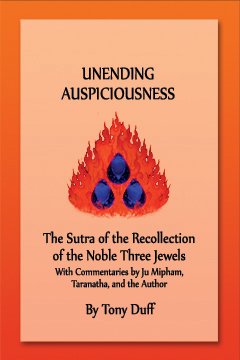
The sutra, in-depth explanations of it, and extensive commentaries by Ju Mipham, Taranatha, and Tony Duff
| Title | Unending Auspiciousness |
| Sub-Title | The Sutra of the Recollection of the Noble Three Jewels with Commentaries by Ju Mipham, Taranatha, and Tony Duff |
| Author | Tony Duff |
| Details | 306 pages, 2 colour plates, 6" X 9" (large format), US$30, available on paper and in PDF and Kindle e-book formats |
| ISBN | paper book 978-9937-838-61-0, e-book 978-9937-572-54-5 |
| Texts | Tibetan text in Tibetan script: Derge edition of the extended recollections of the Three Jewels, and Sutra of the Recollection of the Noble Three Jewels |
The Sutra of the Recollection of the Noble Three Jewels is a compilation of the Buddha's teachings called "the recollections". The recollections are widely used throughout all Buddhist traditions as a way of remembering the Three Jewels and deepening faith in them. This book is a particularly complete collection of everything needed to study, practice, and even translate the Sutra.
The book starts with three chapters of introduction which explain: the origins of the Sutra; the many translation issues raised by the Sutra; and how to study and practise the Sutra. These chapters contain a wealth of material gathered and arranged in one place by the author after years of study of the Sutra. They contain something for everyone. There are discussions of faith and how to arouse it using the Sutra. There are extensive discussions of translation which are a must-read for anyone doing translation work from Tibetan Buddhist texts; they cover important issues of translation that have not been seen in print to date. Then there is helpful guidance on how to study and understand the Sutra. There is also a section on how to access the magic of fundamental reality using the Sutra.
 Read a preview of the book's
Read a preview of the book'ssecond introductory chapter
The chapter in the preview text contains ground-breaking explanations of the translation process that was followed in Tibet and the process that needs to be established for translating Tibetan texts into English and other languages. Clearly, it will be of great interest to almost anyone seriously involved with Tibetan studies. However, the chapter also contains in-depth explanations of the meanings of terms such as buddha, Three Jewels, arhat, and so on and should be of wide interest, even to non-scholars. It is of such interest that we are providing it for free as an independent document.
The body of the book follows. It starts with all of the source materials needed to understand, study, and translate the Sutra (see below for the list of texts included). The sources are backed with information on them and how they relate to the Sutra in the first introductory chapter. Following that, the Sutra itself in Tibetan and English is provided. The book culminates in three major commentaries to the Sutra.
The first commentary, by the author himself, was written directly in English to make it easy for English speakers to understand all the details of the Sutra and the many issues surrounding it. At the same time, it is very extensive, covering issues that even the Tibetan commentaries do not consider. For example, the author presents a number of insights taught by the vidyadhara Chogyam Trungpa when he explained the Sutra in 1982 but which seem to have been lost. It also gathers into one place the many issues surrounding the Sutra raised by the two Tibetan commentaries. The second commentary, by the extremely learned Tibetan Taranatha, has the advantage of being a shorter commentary that it is relatively to understand. The third commentary is the very extensive and rather complicated one by Ju Mipham Namgyal that has become very famous in general these days as the way to study the Sutra. Mipham's commentary is very technical and can be hard to understand in places unless one is already very well versed in Buddhist philosophy. Therefore, the author has provided extensive notes to make it accessible.
The administration of Gangteng Tulku's shedra for his Western students has reviewed our book and the translation of Mipham's commentary in particular and called it "superb". They are strongly recommending it for all the shedra students.
The book contains translations of the following texts:
 | The recollections of buddha, dharma, and sangha as originally taught by the Buddha, in Pali, Sanskrit, and English |
 | The recollections of buddha, dharma, and sangha as extended by Great Vehicle followers, from the Derge edition of the Tibetan Tangyur, in Tibetan |
 | The Sutra of the Recollection of the Noble Three Jewels, edition from Dudjom Jigdral Yeshe Dorje's Collected Works, in Tibetan and English |
 | A Complete Commentary to The Sutra of the Recollection of the Noble Three Jewels by Tony Duff, in English |
 | A Little Explanation of The Sutra of the Recollection of the Noble Three Jewels by Taranatha, in English |
 | A Complete Commentary to The Sutra of the Recollection of the Noble Three Jewels called "A Melody of Unending Auspiciousness" by Ju Mipham Namgyal, in English |
Purchase:
This book is also available in Kindle e-book format. The entire book contains extensive introductory material followed by three major commentaries. Because of the requirements of Kindle books, the entire book has been divided into three Kindle volumes. Each of the Kindle volumes includes all of the introductory material plus one of the major commentaries. The most popular of the three Kindle volumes is volume 1 containing the author's own commentary, because it presents the commentary directly in English avoiding all the constraints of a translation and because it includes all of the important material from the other two commentaries. Volume 2 contains Taranatha's commentary which is the one mainly used by Kagyu followers these days. Volume 3 contains Ju Mipham Namgyal's commentary which is very famous amongst Nyingma followers.